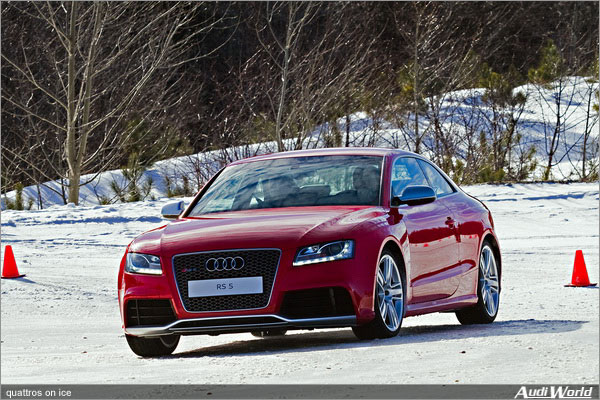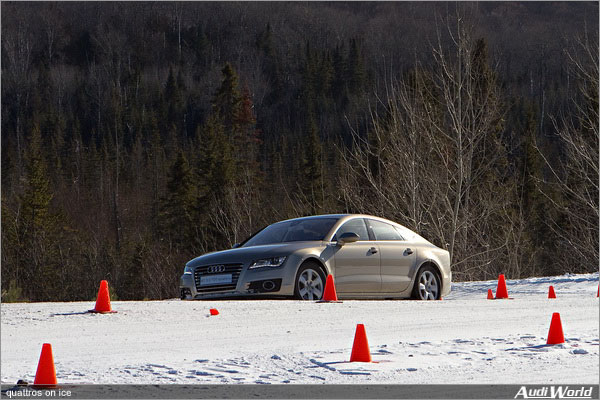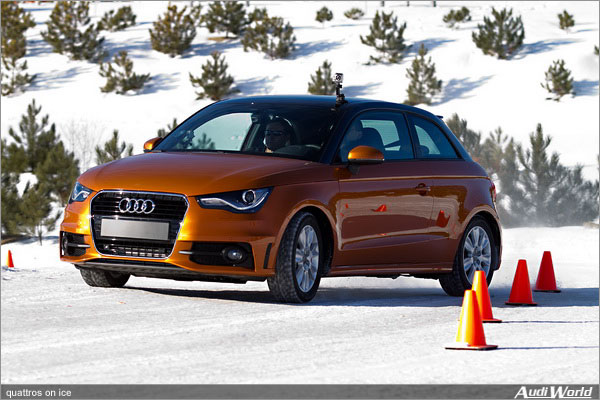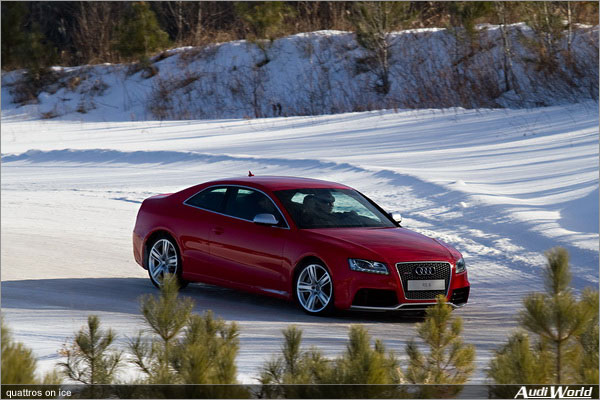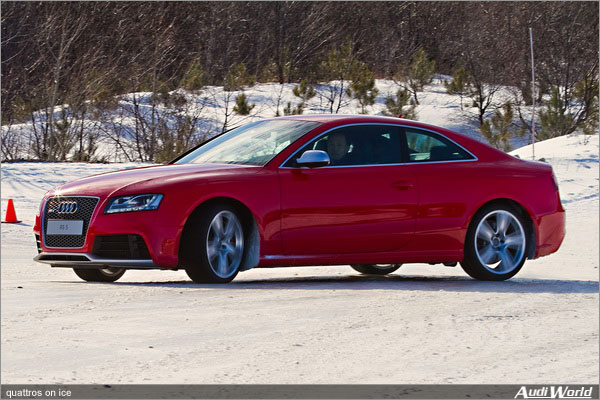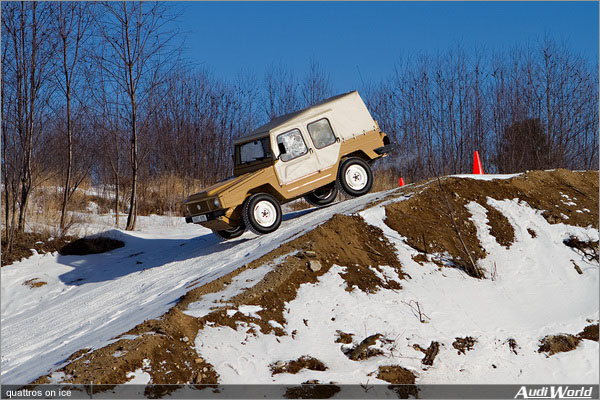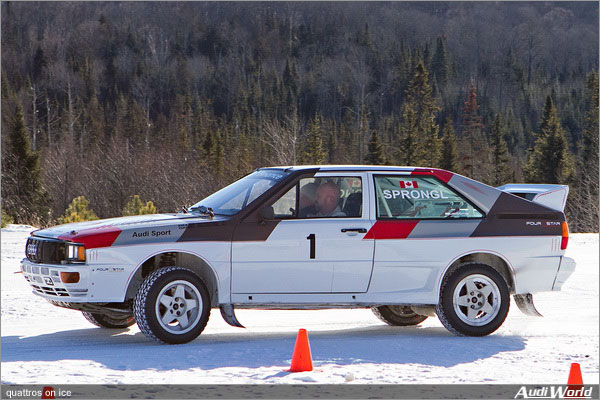quattros on ice
| Notre-Dame-de-la-Merci, Quebec – We recently traveled to Quebec Canada on a mission; to experience a variety of Audis latest quattro models on ice. As part of Audis 30th anniversary of the first Audi Quattro, the folks at Audi thought it would be nice to show off their newest models in a way that makes perfect sense to us, driving them on one of the lowest grip surfaces a driver can ever encounter.
While no stranger to driving in snow and ice on public roads, this was a first time experience on a closed course, and one with such tight turns like the race track at Mecaglisse. This facility was the perfect place to explore the handling characteristics of the newest Audi models, on glare ice. Rumor had it that due to a general lack of snow in the area, the folks at Mecaglisse had been watering the tracks to create a nice icy base layer. We can confirm that the icy layer was in fact very solid and very slippery! The night before we arrived at the track, it had snowed a few inches, making the scenery very pretty, but hiding the ice from view. Fortunately though, our test cars were fitted with studded snow tires (street legal studs) and therefore had no problems finding mechanical grip, most of the time.
Once we settled in at the Mecaglisse facility, and had a quick briefing as to the days activities (and yet more coffee), we picked our first test subject. Because we haven’t had any firsthand experience with the new A7, and it’s a car we’re really excited about, we lept into the waiting A7 TDI. As expected, the A7 was phenomenally comfortable and stable on the icy skid pad. We were one of the first cars of the day to venture out on the pad, so it was still somewhat snow covered, giving us a false sense of security. When driven normally, the A7 circled the pad easily, finding grip with its studded tires, and adjusting attitude with the on board wizardry that is ESP, combined with the new crown gear center differential, which is all new for the A7 (as well as the A6 and RS5). Once we started pushing a little harder though, we found that on this glare ice surface, the A7 didnt exactly turn in the way we expected it to. With no hand brake to initiate a pendulum turn, we had to lower our entry speeds in order to not push wide. Once we figured out the best way to make the front tires bite though (using the brakes), we found it very easy to complete a pendulum turn with the abundant torque from the 3.0TDI engine. The next test subject was a car which we will most likely never see in the USA, the A1 quattro. This diminutive hatchback was absolutely adorable, and its a bit of a shame that the A1 is not destined for our roads. There were 2 A1 quattros present, and both were pre-production prototypes, and neither had ESP functioning. The car we drove was equipped with the 1.4 liter TDI, and a manual transmission. For such a small car, the front seats were very roomy, and the build quality was typical Audi. We didnt press the car too hard given its uber rare status, but we got a good enough feel of it that we think Audi should have no problem selling many of these micro quattros. From the micro A1, we slid into the RS5, which is a bit of a culture shock perhaps, but in reality, the RS5 when driven mildly is equally benign. Before we set off to attack the ice covered tracks, we returned to the skid pad to experiment with the settings for the sports rear differential, which has the ability to actually overdrive the outside wheel in a corner, which not only helps with stability, but it greatly reduces understeer while keeping the rear in line. Since the RS5 is also equipped with the all new crown gear center differential, front to rear bias is variable at all times (though the normal state is 40 to the front and 60 to the rear) but it never felt overly tail happy. As our Audi engineer/driving instructor fiddled with the MMI knob, changing the settings on the sport differential, we drove around the circle at an ever increasing speed. As soon as he engaged the active differential, we were able to maintain our arc around the circle perfectly, on glare ice. Its at this point I should mention that the tires on this particular car had previously shed themselves of all of the studs that were originally inserted into the tires, leaving slightly torn up snow tire tread as our only interface to the ground. This made the ice all the more slippery, yet, the car clawed its ragged and worn tires at the ice, and managed to find grip, somehow. It was truly amazing, and left the deepest impression of any of the cars we drove that day. Once we got the RS5 onto the ice courses, we were in love. We found the natural balance of the chassis and pinpoint handing to be superb. Weve always said that a car that handles well on dry pavement should handle well on ice, and conversely, a car that handles poorly on dry pavement will handle poorly on ice and snow. Naturally then, the RS5 was an absolute joy to drive on the ice. By the time we got out in the RS5, many other cars had passed over the icy corners of the Mecaglisse tracks, and the studded tires actually smooth the ice somewhat, which meant it was very nicely polished for us. No matter though, the RS5 just hooked up as if it was on a much grippier surface. Compared to the much heavier and longer A7, the RS5 was much more flickable, and it responded very well to throttle inputs – both the chop throttle to initiate a turn, and the mash of the pedal to hurl the rear end out for the full opposite lock powerslides up the hill on the final turn of the course. It was hysterically fun to drive, and the monstrous power of the 4.2 V8 was controlled exceedingly well by the quattro system, putting power to the ground and keeping the car going in its intended direction. The last vehicle we had the chance to drive on a special course at Mecaglisse was the VW Iltis. Some might say, why a VW? Well its quite simple actually The Iltis drivetrain was the basis for the drivetrain on the original Quattro. Even though they were comparatively simple, the early systems were very effective. We drove the Iltis on what we guessed was a motocross course, based on the huge hills, jumps, and banked turns we were navigating through and over. Because of its age and stiff suspension, we were in no hurry to break the car, or our backs, so we drove pretty conservatively. There were a few times when our instructor urged a little more speed, to prevent the car from bogging down (which we naturally obliged). We took the Iltis up and down some steep hills, and it was an absolute hoot. Also on hand for this event were 2 original factory Audi Quattro rally cars, one a long wheelbase version driven by Canadian rally ace Frank Sprongl, and the other a short wheelbase Sport Quattro, driven by Harald Demuth, who is none other than the man who drove the Audi 100 quattro in the famous original Audi Ski Jump TV commercial. Both men were giving rides in the classic rally cars, which was a thrill for everyone who went out for a ride, and it was a thrill to see the cars on display. All said, this was a great experience driving some of Audis finest examples on some very slippery Canadian ice! |

